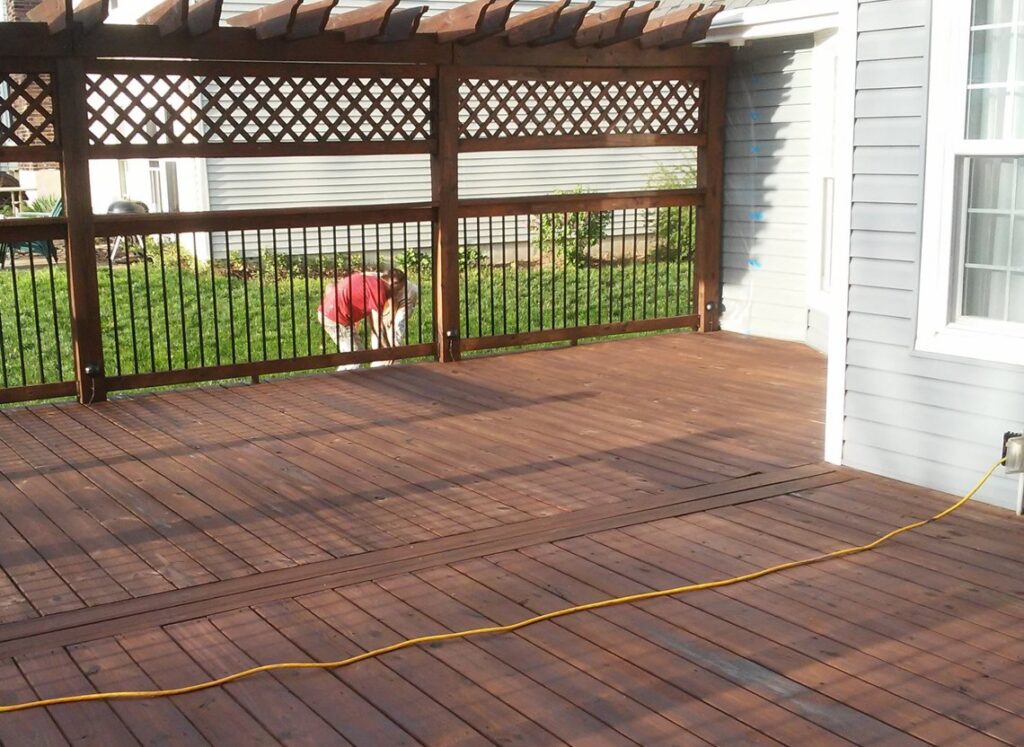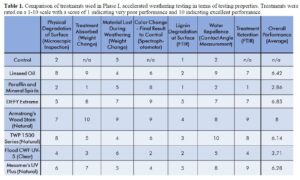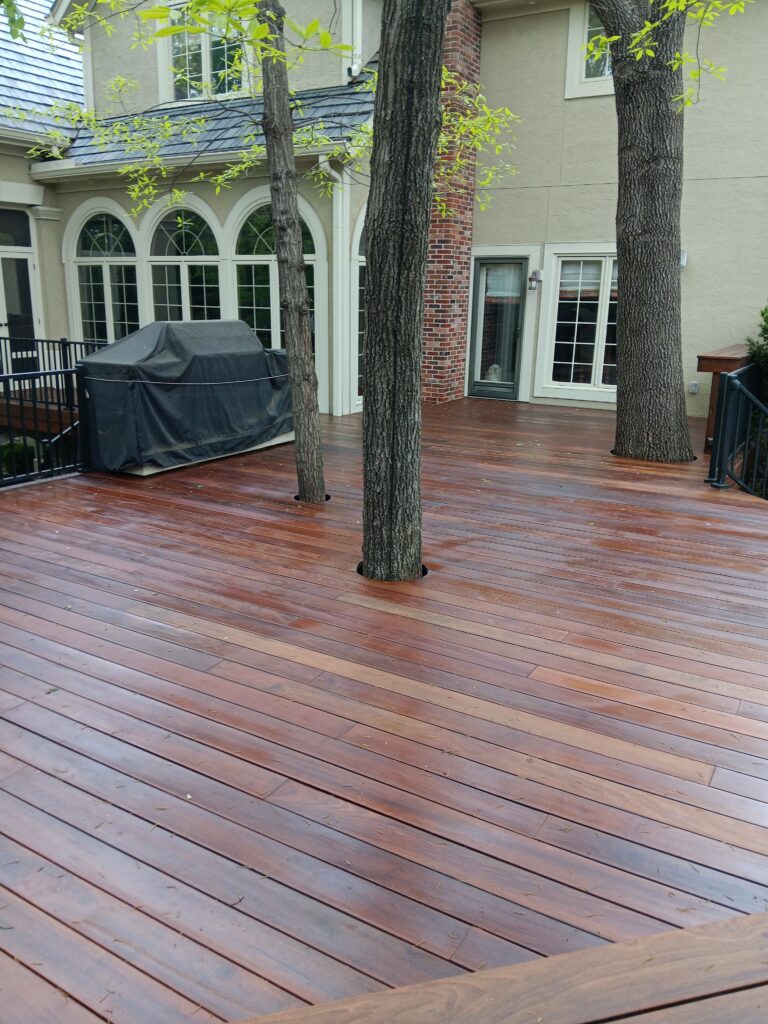Oil-Based Deck Stain vs. Water-Based Stain
For homeowners seeking a deck stain for their outdoor decks, the choice of stain can feel like a pivotal decision. And it is. It’s an investment in both aesthetics and longevity, guarding against the effects of sun, rain, and everyday wear. I urge homeowners to approach the “water-based is always better now” narrative with caution despite what many contractors tell you The “best” stain isn’t a universal truth; it’s the one that best meets the unique demands of your deck and your personal priorities. Don’t be swayed solely by marketing claims; consider the long-term implications and the potential for the unsightly reality of a peeling deck.
Oil-Based Deck Stain vs. Water-Based Stain
Kansas City, MO:
For homeowners seeking a deck stain for their outdoor decks, the choice of stain can feel like a pivotal decision. And it is. It’s an investment in both aesthetics and longevity, guarding against the effects of sun, rain, and everyday wear. For years, oil-based stains reigned supreme, lauded for their deep penetration and robust protection. However, the rise of water-based formulations has introduced a compelling alternative, sparking a debate that often leaves homeowners scratching their heads: which is truly the best for their beloved deck?
Having navigated hundreds of deck staining projects and witnessed the use of both oil-based and water-based options, including a personal journey that revealed the persistent chipping and peeling even in high-quality acrylics water-based deck stains, I want to provide an in-depth, experience-driven comparison to help you make an informed decision. This isn’t just a recitation of manufacturer claims.
The Legacy of Oil-Based Stain: Deep Penetration and Enduring Protection

For decades, oil-based stains were the undisputed champion for exterior wood. Linseed oil has been used as a wood finish for centuries, and its use in Yellowstone National Park’s historic log buildings, including the Old Faithful Inn, has been documented since at least 1903. Their inherent properties offered a compelling package of benefits:
- Deep Penetration: The smaller molecular structure of oils allows them to sink deep into the wood fibers, creating a robust barrier from within. This saturation provides excellent barrier against moisture, a primary culprit in rot and decay.
- Enhanced Wood Grain: Oil-based deck stains have a knack for enriching the natural beauty of wood. They tend to highlight the grain patterns, adding depth and a warm, traditional aesthetic that many homeowners find appealing.
- Durability and Weather Resistance: Historically, oil-based stains have been praised for their resilience against the elements. They often form a more durable finish that can withstand the rigors of sun, rain, and temperature fluctuations.
- Superior Flow and Leveling: Application is often smoother with oil-based stains. They tend to flow and level well, minimizing brush strokes and resulting in a more professional-looking finish, particularly on larger deck surfaces.
- Longer Open Time: The slower drying time of oil-based stains is a double-edged sword, but it offers a significant advantage during application. It provides more time to work the stain, blend sections seamlessly, and correct any errors before the finish sets. A typical dry time for light traffic is 8 hours or more depending on the weather.
However, the reign of oil-based deck stains isn’t without its caveats:
- Prolonged Drying Time: The extended drying period can be inconvenient, requiring careful planning to avoid foot traffic or rain exposure. Up 8-24 hours for light traffic.
- Potent Odor and VOCs: The high volatile organic compound (VOC) content in many oil-based stains results in strong fumes, necessitating excellent ventilation during application. Environmental concerns surrounding VOCs are also a significant factor for many.
- Harder Cleanup: Cleaning brushes and spills requires mineral spirits or paint thinner, adding an extra cost to the project.
The Rise of Water: Convenience and Environmental Consciousness
If your shopping for deck stain, water-based stains have emerged as a strong contender in most large home improvement stores. This is driven by
 advancements in technology and a growing demand for more user-friendly and environmentally responsible products:
advancements in technology and a growing demand for more user-friendly and environmentally responsible products:
- Rapid Drying Time: One of the most significant advantages of water-based stains is their quick drying time. This allows for faster project completion and often enables multiple coats to be applied in a single day.
- Low Odor and VOCs: The low VOC content translates to minimal odor, making them a more pleasant option to work with, especially for indoor/outdoor transitions or enclosed deck spaces. They also align with increasing environmental regulations and homeowner preferences for greener products.
- Easier Cleanup: Soap and water are all that’s needed for cleaning brushes and spills, simplifying the process considerably.
- Color Clarity and Retention: Water-based stains often offer excellent color clarity and are less prone to yellowing over time, allowing the chosen hue to remain truer for longer.
- Versatility in Application: They can often be applied over existing oil-based stains with proper preparation, offering greater flexibility for recoating.
Despite these compelling benefits, the experience of many, including my own, highlights some critical considerations for Oil-Based Deck Stain vs. Water-Based Stain deck stains on demanding outdoor decks:
- Limited Penetration: The larger water molecules generally don’t penetrate the wood as deeply as oil, potentially offering less subsurface protection against moisture.
- Faster Drying Time (a double-edged sword): While quick drying is a benefit, it can also be a disadvantage during application, potentially leading to lap marks if the stain isn’t applied quickly and evenly, especially in warm or windy conditions.
- Film Formation and the Peeling Problem: Many water-based deck stains, particularly solid or heavily pigmented acrylic formulations, tend to form a film on the wood surface. My personal experience, even with high-quality acrylics, has shown that this film, despite its initial protective qualities (the film itself), is susceptible to cracking, chipping, and peeling over time on outdoor decks. The constant expansion and contraction of the wood, coupled with UV exposure and wear, can stress this film beyond its limits.
- Adhesion Challenges: Proper surface preparation is paramount with water-based stains. Any existing coatings, dirt, mildew, or mill glaze can severely impede adhesion, leading to premature failure.
Water-based Stain Vs. Paint
Both water-based stains and paints rely on a similar foundation of pigments for color, water as a carrier, and acrylic or other synthetic resins as binders to adhere to the wood. However, the most significant difference lies in their formulation objectives: water-based deck stains are engineered with a lower pigment and binder concentration to color the wood while in some cases allowing its natural grain to remain visible (in the case of semi-transparent water based) and often to penetrate the surface slightly, whereas water-based paints are formulated with a much higher pigment and binder load to create an opaque film that conceals the wood grain and provides a substantial layer of surface protection. Solid water-based stains have more pigmentation that mimics paint.
Research into Oil-Based Deck Stain vs. Water-Based Stain
I would be remiss not to mention this long-term study initiated in the summer of 2015 to evaluate protective treatments for historic log structures in Grand Teton National Park. It underscores the complexities of achieving durable wood protection. Research conducted on wood coatings for historic structures provides a comparison between various treatments for outdoor wood. This study evaluated several products, including both oil-based and water-based stains, by assessing physical surface degradation, material loss, color stability, and water repellency. The initial findings indicated that the oil-based Armstrong’s Wood Stain (Natural) exhibited the highest overall performance across these metrics. In contrast, a water-based acrylic stain demonstrated lower overall effectiveness/
The initial results from this research produce valuable insights into the comparative performance of various wood treatments, highlighting that even established solutions can exhibit different strengths and weaknesses under real-world weathering conditions. It can be found here:
https://journals.uwyo.edu/index.php/uwnpsrc/article/download/4105/4105

The Verdict: Oil-Based Deck Stain vs. Water-Based Stain
Ultimately, there is no universally “best” stain for every deck. The optimal choice hinges on a multitude of factors specific to your project:
- Climate and Exposure: Decks in regions with harsh weather conditions, intense sunlight, and significant temperature swings may still benefit from the deeper penetration and robust protection traditionally offered by high-quality oil-based stains. However, advancements in water-based formulations are narrowing this gap.
- Wood Type: The porosity and natural characteristics of your deck wood can influence how well different stains penetrate and adhere.
- Desired Aesthetic: If a deep, rich enhancement of the wood grain is paramount, oil-based stains have historically excelled. For vibrant, modern colors and clarity, water-based options often shine.
- Application Skills and Time Constraints: DIYers with less experience might find the longer open time of oil-based stains more forgiving. Those prioritizing speed and easy cleanup will lean towards water-based options.
- Environmental Concerns: For environmentally conscious homeowners, the lower VOC content of water-based stains is a significant advantage.
- Maintenance Preferences Oil-Based Deck Stain vs. Water-Based Stain: While the
 initial application of oil-based stains might offer longer intervals before reapplication in some cases, the cleanup and potential stripping can be more involved. Water-based stains often allow for easier recoating with proper preparation.
initial application of oil-based stains might offer longer intervals before reapplication in some cases, the cleanup and potential stripping can be more involved. Water-based stains often allow for easier recoating with proper preparation.
Experience: Oil-Based Deck Stain vs. Water-Based Stain
Based on my experience of Oil-Based Deck Stain vs. Water-Based Stain, particularly the frustrating reality that even high-quality acrylics will chip and peel on outdoor decks, I urge homeowners to approach the “water-based is always better now” narrative with caution despite what many contractors tell you. While water-based stains have made significant strides, the fundamental challenge of a film-forming coating for outdoor wood structures is that they constantly get wet, dry-out, freeze, then thaw (constantly moving), which puts tremendous pressure on the film. This is what causes chipping and peeling even on a perfectly prepared surface.
For demanding deck staining environments, especially those with significant exposure and wood movement, a high-quality penetrating oil-based deck stain might still offer superior long-term protection against the elements and the dreaded chipping and peeling. While the VOCs and cleanup are drawbacks, the deep penetration and lack of a thick surface film can lead to better adhesion and less maintenance headaches down the line.
However, if low odor, quick drying times, and environmental considerations are paramount, and you are meticulous about surface preparation and application, a premium water-based deck stain specifically formulated for exterior decks can be a viable option. Be prepared for potentially more frequent reapplication and vigilant maintenance to prevent film breakdown.
Oil-Based Deck Stain vs. Water-Based Stain
The key takeaway is to move beyond broad generalizations and delve into the specifics of your project, the quality of the product, and the crucial steps of preparation and application. The “best” stain isn’t a universal truth; it’s the one that best meets the unique demands of your deck and your personal priorities. Don’t be swayed solely by marketing claims; consider the long-term implications and the potential for the unsightly reality of a peeling deck.
